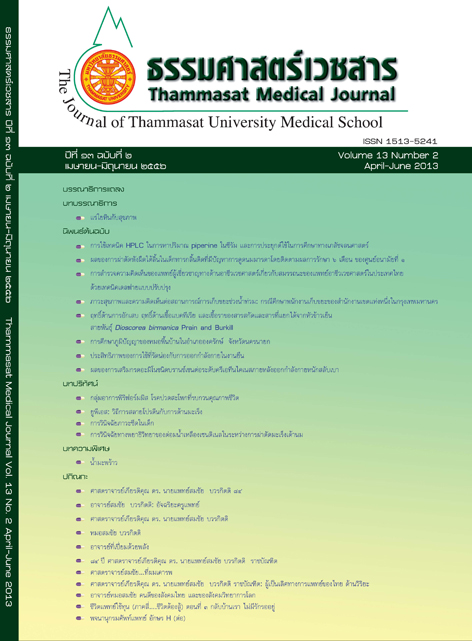An alternative high performance liquid chromatographic method for determination of piperine in serum: Application to pharmacokinetic studies
Keywords:
Piperine, HPLC-UV, Pharmacokinetics, BenjakulAbstract
Introduction: Piperine, a major alkaloid found in Benjakul remedy of the spice black and long peppers Piper longumLinn. and Piper nigrum Linn., is used as a traditional medicine in several tropical countries particularlyAsia. The aim of the study was to establish an alternative high performance liquid chromatography(HPLC) with ultraviolet (UV) detection method, which is relatively simple, rapid, sensitive, accurate andreproducible method for determination of piperine in human serum.
Methods: Piperine and the internal standard β-17-estradiol acetate were separated from serum on a ZORBAXEclipse XDB-C18 (4.6 x 250 mm, 5 μm particle size) column, with the mobile phase consisting ofa mixture of 25 mM KH2PO4 and acetonitrile at the ratio of 35:65 (v:v) running at a flow rate of1.0 mL/min. Ultraviolet detection was at the wavelengths of 340 and 280 nm for piperineand β-17-estradiol acetate, respectively. Retention times of piperine and β-17-estradiol acetate were4.6 and 10.0 min, respectively. Sample preparation was done by extraction of protein with the mixtureof 9:1 (v:v) ethylacetate and propanol. The developed method was validated according to guidance forindustry bioanalytical method validation.
Results: Good precision and accuracy were obtained for both within-day repeatability and day-to-day reproducibility.Limit of quantification (LOQ) for piperine was 25 ng/mL using 500 μL sample. The mean recoveriesfor piperine were between 86.44-99.30%. The method was successfully applied for a pharmacokineticstudy of piperine in healthy Thai males.
Discussion and Conclusion: An alternative analytical method for the determination of piperine in serum using HPLC with UV detection established in this study meets the criteria for application to routine clinical drug level monitoring orpharmacokinetic study. The developed method is relatively rapid, simple, and sensitive.
Key words: Piperine, HPLC-UV, Pharmacokinetics, Benjakul



